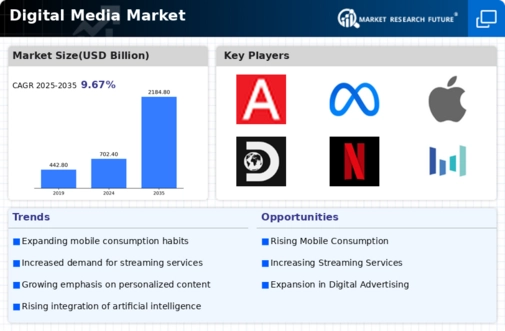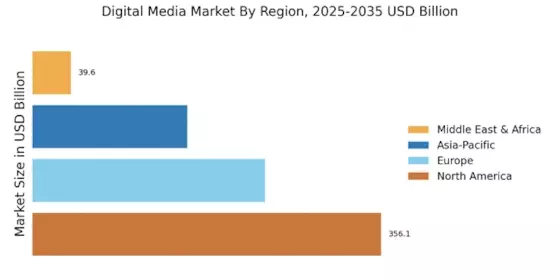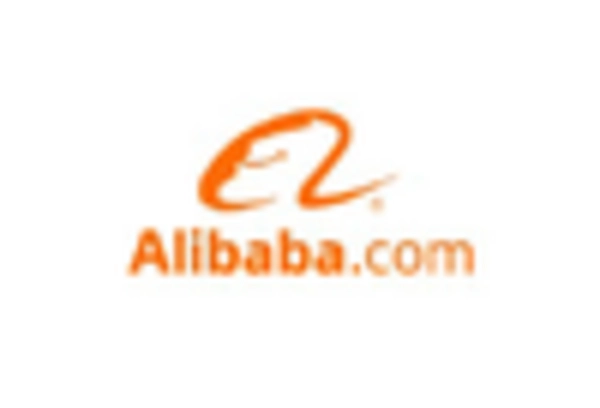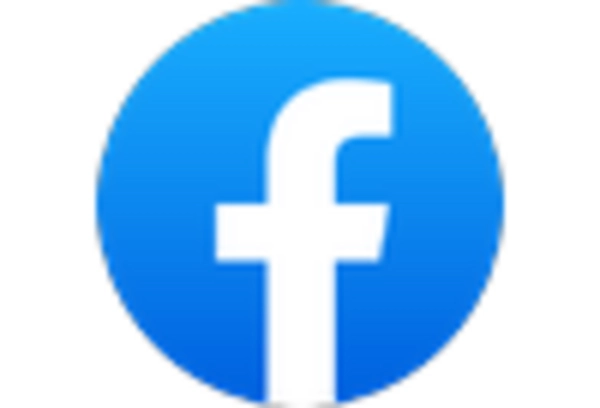Emergence of New Content Formats
The emergence of new content formats is reshaping the landscape of the Digital Media Market. Innovations such as short-form videos, podcasts, and interactive content are gaining traction among consumers, particularly younger demographics. As of 2025, the podcasting industry alone is expected to surpass 1 billion in revenue, reflecting a growing appetite for diverse content types. This diversification allows media companies to cater to various audience preferences, thereby expanding their reach. Additionally, platforms that support user-generated content are likely to thrive, as they encourage creativity and community engagement. Consequently, the Digital Media Market is witnessing a shift towards more dynamic and varied content offerings, which could enhance user loyalty and drive revenue.
Expansion of Mobile Internet Access
The proliferation of mobile internet access appears to be a pivotal driver for the Digital Media Market. With the increasing penetration of smartphones and mobile devices, consumers are now able to access digital content anytime and anywhere. As of 2025, mobile internet users are projected to reach approximately 5 billion, indicating a substantial audience for digital media platforms. This accessibility encourages content consumption on-the-go, thereby enhancing user engagement and retention. Furthermore, the rise of 5G technology is likely to facilitate faster download speeds and improved streaming quality, which could further stimulate growth in the Digital Media Market. As a result, companies are increasingly optimizing their content for mobile platforms to capture this expanding user base.
Adoption of Advanced Analytics and AI
The integration of advanced analytics and artificial intelligence (AI) technologies is transforming the Digital Media Market. These tools enable companies to analyze consumer behavior and preferences with unprecedented accuracy. By leveraging data analytics, businesses can tailor their content and marketing strategies to meet the specific needs of their audience. For instance, AI-driven algorithms can predict trends and suggest personalized content, enhancing user experience. As of 2025, it is estimated that over 70% of digital media companies are utilizing some form of AI in their operations. This trend not only improves operational efficiency but also fosters deeper connections with consumers, thereby driving growth in the Digital Media Market.
Growing Demand for Streaming Services
The growing demand for streaming services is significantly influencing the Digital Media Market. As consumers increasingly prefer on-demand content over traditional broadcasting, the number of streaming subscribers is expected to exceed 1 billion by 2025. This shift is driven by the convenience and flexibility that streaming platforms offer, allowing users to watch content at their own pace. Additionally, the proliferation of original content produced by streaming services is likely to attract new subscribers and retain existing ones. As competition intensifies among platforms, investments in exclusive content are expected to rise, further propelling the growth of the Digital Media Market. This trend indicates a fundamental change in how media is consumed and monetized.
Increased Investment in Digital Advertising
The surge in digital advertising investment is a crucial driver for the Digital Media Market. As businesses increasingly recognize the effectiveness of digital channels, advertising expenditures are projected to reach over 500 billion by 2025. This trend is fueled by the ability to target specific demographics and measure campaign performance in real-time. Social media platforms and streaming services are particularly benefiting from this shift, as advertisers seek to engage consumers where they spend the most time. Moreover, the rise of programmatic advertising is likely to streamline the ad buying process, making it more efficient. This influx of advertising dollars not only supports content creation but also enhances the overall ecosystem of the Digital Media Market.


















Leave a Comment